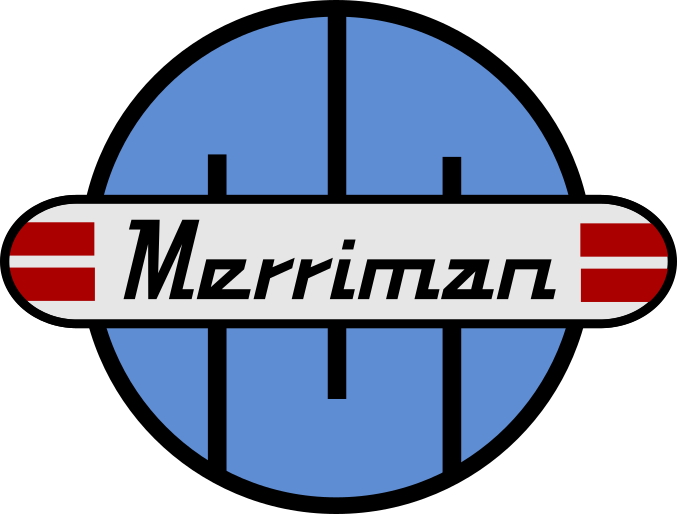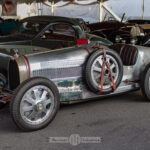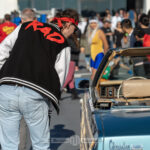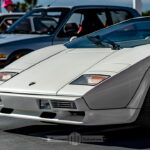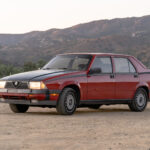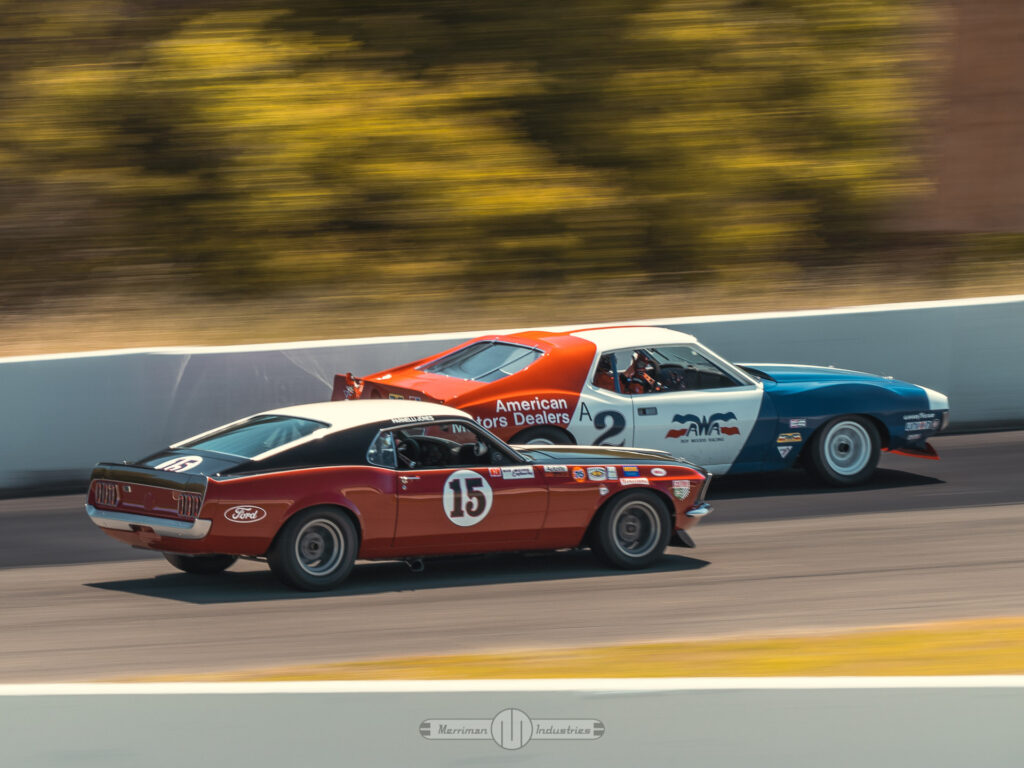
A History of Motorsport by the Sonoma Speed Festival

The landscape of vintage racing is well populated. There are opportunities to scratch a vintage racecar itch all over the world, from larger-than-life phenomenons like Goodwood Festival of Speed and Rolex Monterey Motorsports Reunion to the regular weekend events by the SVRA and other organizing bodies. This makes it challenging for a new event to break in, especially when they’re aiming for top billing.
Sonoma Speed Festival has that ambition and in their maiden outing they got a lot of things right. Live streaming with professional commentary for all the race days and a strong social media presence. A food court with astroturf lawns full of activities for the kids and a wine tent drawing on the incredible Napa Valley setting for the adults. While lacking those accoutrements might make an event a failure having them doesn’t guarantee success either. For that you need cars; lots of cars and the right cars. This is where the Sonoma Speed Festival shone and why you’ll be hearing those three words together again for years to come. Spread across ten race groups, the organizers brought out over a hundred significant racecars spanning well over one hundred years of racing history
- Exhibition Group – 1900-1918 Ragtime Racers
- Race Group 8 – 1932-1952 Prewar Grand Prix Cars
- Race Groups 1 & 2 – 1949-1959 Sports Production Cars
- Race Group 3 – 1959-1965 Production/GT Cars Up to 5 Liters
- Race Group 5 – 1964-1973 FIA Manufacturer’s Championship
- Race Group 7 – 1965-1969 Under 2.5 Liter
- Race Group 6 – 1966-1972 Historic Trans Am
- Race Group 10 – 1971-1980 IMSA Camel GT
- Race Group 4 – 1966-1985 Masters Historic Formula One
- Race Group 9 – 1981-1990 Prototypes, FIA Group C, & IMSA GTP and 1995-2015 Masters Endurance Legends
- Full Gallery
When Grease Monkeys were Pioneers
Exhibition Group – 1900-1918 Ragtime Racers
The oldest run group was composed entirely of centenarian race cars. Just like a 100 year old human, a car of that age doing anything is impressive. But unlike our great great grandparents, these antiques are far from sedate. Offering a visual feast of rudimentary engine technology, they were the most interesting in the pits and on the starting line. The mechanics performed pre-run lubrications with an oil can misplaced from the Wizard of Oz then furiously pumped fuel and oil to prime the large displacement monsters. As they wrestled with hand cranks the exposed valvetrains clicked and clacked in the open and the carburetors coughed. An animalistic roar announced success and each individual engine power pulse spewed distinct fireballs out of the short straight exhaust pipes. The pilots donned white jumpsuits to match white mustaches, climbed onto the tractor-like seats, and lurched onto the track.
Even an older course like Sonoma Raceway is built for cars a hundred miles per hour faster than these. The lumbering beasts climbed each hill furiously but cruised around the corners as if they were freeways. The drivers and mechanics leaned into the curves with glee, waving and egging each other on. It wasn’t much of a competition; the sport was clearly in the participation and the bond of loving vehicles that the rest of the world has nearly forgotten.
Every Hero Has an Origin Story
Race Group 8 – 1932-1952 Prewar Grand Prix Cars
“The Golden Age of Racing” is an increasingly controversial title as the ensuing decades have given us equally legendary racecars. But the moniker doesn’t feel out of place given the inescapable influence it continues to have on the automotive landscape even today. A young Enzo Ferrari was making his name at the helm of the Alfa Romeo racing team, the racecar driver was celebrated as an international celebrity, and a foreshadowing of World War 2 was played out on the Grand Prix circuit as the French, Italians, and English all struggled to modernize and beat the technologically dominant Germans. The automobiles of each nation were morphing into iconic forms and shapes that matched their landscapes while engineers converged on solutions that would become standard practice.
What’s most surprising to those who are only familiar with prewar cars from images of 101-point restorations on the lawns of Pebble Beach is how hard they run the race cars. Given the insane danger and fatalities during their original run it’s for the best that no one drives the cars at ten tenths anymore. But eight tenths offers more than enough danger and is regularly the threshold at vintage Grand Prix events. At Sonoma Speed Festival it was the British ERA cars that pushed hardest and took the top three spots at the end of the weekend. This is a common phenomenon in vintage racing: the fastest cars today are often not the most iconic or even successful in their heyday. But now they’re more affordable to purchase and service so they’re often in the hands of enthusiasts who prioritize racing and want a car with less to lose. The field had more storied marques represented like Bugatti, Talbo-Lago, and Bentley but it was the little ERAs that dove into each corner harder to finish first. (Fun fact: it’s this same ERA that produced the only production turbocharged Mini Cooper!)
New Sports Cars for a New World
Race Groups 1 & 2 – 1949-1959 Sports Production Cars
It’s hard not to romanticize all eras of racing but I imagine the club racing tracks across the USA in the late ’40s and ’50s had an absolutely electric atmosphere. Postwar prosperity was combined with a glut of returning soldiers who had been exposed to European sports cars and racing then given a crash course in mechanical aptitude with Jeeps, war planes, and the whole mechanized war effort. They came home to a nation still very much in love with the automobile and got to work at racing.
This perfect storm was so well represented at Sonoma they were split across two racing groups. A whole slew of cars with ‘Special’ in the name were present; short production run cars or even one-offs built in shops and garages from Southern California to Canada, marrying throaty V8s to European-style chassis’ and hand formed bodies, and often surprisingly competitive with the now established manufacturers. But even some of those legendary marques were struggling for fame and recognition at the time. The British automotive industry’s titans like Jaguar, Lotus, and Aston Martin were still in their early days, building their legendary reputations. They themselves were still underdogs with companies like Ferrari, Maserati, and Mercedes restoring their racing programs to pre-war levels.
Golden Age of Sports Car Racing
Race Group 3 – 1959-1965 Production/GT Cars Up to 5 Liters
There’s something mind-breaking about seeing cars elevated to a status somewhere between iconic and godlike turn a wheel in anger. Ferrari 250s, Jaguar E-Types, Shelby Cobras, and their competitors are something more than singular models: they’ve inspired countless replicas, pop culture, and the very language we use to talk about and design sports cars even today. If that sounds like exaggeration it’s only because they’ve been so imitated that the familiarity with their form masks their innovation.
Racing had found a perfect stride during those years. The world was as car-crazy as ever, engine technology ratcheted power to levels that could exceed tire grip by a country mile, and drivers laid it all on the line to perfect their craft. But one man made a larger mark than most; Ferrari’s Maranello factory turned industry into art while perfecting the form of his screaming V12 sports and touring cars. Jaguar impressed even him with their stunning E-type while Shelby and Ford put a target on his back with the racing program that spawned the Shelby Cobra. But the iconic Ferrari 250 and 275 models became a benchmark of both engineering and art that’s remains a yardstick today. These cars are the highlights of museum exhibits, stars of almost any show they enter, and cherished centerpieces of car collections yet Sonoma Speed Festival welcomed five Ferrari 250s, including two GTOs, and one 275 GTB.
Living Legends
Race Group 5 – 1964-1973 FIA Manufacturer’s Championship
The 1960s and 1970s were a time when the public still looked to racing for their next car purchase and so every manufacturer with coin to burn wanted to show off their engineering chops on the track. Both then and now nothing shows off a well put together car like endurance racing, most of all the flagship race at Le Mans. A drive about as long as crossing the United States in a single day with speeds greatly exceeding 200 MPH is one of the most brutal tests of a racing car ever devised yet they lined up for the punishment. Homologated production cars might have been a more direct showing of a manufacturers offerings but all eyes were on the prototype class where engineering muscles could really be flexed.
First Ferrari perfected the art of racing with cars fast enough to win but moderate enough to be reliable. Ford threw their hat in the ring in the late ’60s, lobbing money and horsepower at the problem, finally getting their turn on the podium. Then Porsche made the ’70s a near continual run of dominance and wrote their own myths of turbochargers and flat-12 monsters. Meanwhile a parade of companies from all over the world showed up with their finest to valiantly attempt to unseat these champs. The stories of these battles are cinematic in scope, as Hollywood recently noticed, and the cars have A-list star power. The blue and orange Gulf livery splashed across the tail of a 917K or the thunder of a 427 cubic inch GT40 is truly witnessing history in motion.
Doing More with Less
Race Group 7 – 1965-1969 Under 2.5 Liter
While the top classes in sports car racing wrapped bespoke hand-crafted bodies around big throaty engines there was plenty of room for more attainable production cars with small displacement engines to write their own history on the race track. “Race on Sunday, sell on Monday” wasn’t just for Nascar and even America was starting to think small. The Trans Am Under 2/2.5 Liter class was the battlegrounds for companies to jumpstart their motorsport pedigree, culminating with the Datsun 510 vs Alfa Romeo GTV rivalry in the early 1970s. Across the Atlantic, Europe’s long distance road rallies and endurance races spawned homologation specials with curb weights far south of 1000 kg and screaming four cylinder engines.
When a European sports car fan complains of their favorite marque migrating too far from their roots they’re often thinking wistfully of the cars raced during these years. Lotus’ dogged minimalism, Porsche’s robust but unconventional design, and Datsun’s bulletproof industrialism are just examples of manufacturers hitting a stride that they either carried forward or their fans ardently wish they had. It was easy to see why at Sonoma: Alfa Romeos sang glorious songs and changed directions faster than San Francisco weather, Porsches turned in and pirouetted with rear-engine agility, origami-shaped Datsuns took abuse without complaint and battled for the top spots, and Lotuses were so small and light they seemed to be worn by their drivers like suits.
A Crash Course in Muscle Car Handling
Race Group 6 – 1966-1972 Historic Trans Am
The late ’60s and early ’70s was the best American racing has ever been in many arenas: drag racing featured funny cars packing quadruple-digit horsepower counts, NASCAR flirted with the 200 MPH mark in cars with production roots, and even European sports cars were gracing our shores in large numbers at events large and small. At the nexus of all of that was a brief golden Valhalla known as the Trans Am Over 2 Liter (up to 5 liter) class.
American muscle cars based on production models with finely tuned V8s chewing up twisty road courses alongside nimble European sports cars and piloted by some of the great names in racing. It’s a racing fan’s fever dream and Sonoma Speed Festival celebrated it with reverence. AMC Javelin AMXs left red, white, and blue streaks all over the course, mixing it up with a lone lime green Sam Posey Dodge Challenger. A fleet of Mustang Boss 302s in high impact color schemes tangled with vibrant orange Genesee and deep blue Penske Camaros, reliving the early days of one of the great model rivalries.
All the sculpted aluminum body work of dedicated European racecars has a hard time competing with the visual impact of fastback muscle cars in vibrant liveries duking it out. That’s hardly hyperbole; this class raced harder than any other! The heavy cars dove into corners, late on the brakes and early on the gas to launch into two- and three-way drag races down the straights. It was a ritualistic dance to the rhythm of V8 engines beating like war drums.
Finding Then Ignoring the Limit
Race Group 10 – 1971-1980 IMSA Camel GT
Any bitterness that the IMSA Camel GT series putting a nail in the coffin of the golden age of Trans Am racing was soon mollified when the IMSA cars morphed into fire-breathing monsters. Beginning with modified production cars not dissimilar to Trans Am, before long the lunatics were running the asylum and IMSA started to produce some of the wildest production-based racecars ever built.
Unlike Trans Am that saw a distinct split between the large bore Americans and diminutive Europeans, IMSA threw everyone into an ever-changing mix of classes and shifting rule sets. A mix of silhouette racers on tube chassis and production-based cars shifted from class to class. BMW’s fledgling M division took a path through the series like a superhero origin story as their refined touring E9 donned the red, purple, and blue Batmobile aero package to transform into the CSL. By then Porsche had little to prove on the race track and the new 914 winning the inaugural IMSA championship reminded everyone of that. But the humble origins of the 911 couldn’t have predicted how far they would push the platform for IMSA; eventually adding turbochargers, a spoiler the size of a dining room table, and flattening out the front like ironing a shirt. Meanwhile Chevrolet entered their third decade developing their small block V8 for racing and stuffing that motor into everything from factory Camaros to tube chassis Monzas was a simple but dominant recipe. This amazing variety was the draw of IMSA racing both in its original run and at the Sonoma Speed Festival. There was incredible variety of form and philosophy represented in the field, from Porsches on steroids to torpedo-shaped Ferrari 512 BBLMs.
Upside Down Airplanes
Race Group 4 – 1966-1985 Masters Historic Formula One
Formula cars have grown more alien in the automotive landscape ever since Cooper-Climax moved the engine to the back. Spindly torpedo-shaped capsules with odd tubes and fat wheels jutting out at all angles flitting around race tracks seems like an entirely different world than lumbering production cars, especially with the backdrop of the Space Race. In the 1960s Formula One was dabbling in aerospace technology but in the 1970s Lotus spearheaded the effort to take Formula 1 fully into ground-based jet fighter technology. Wings and foils were tacked on all corners like turn-of-the-century flying machines until the cars stuck to the track like glue.
The breakneck rate of chassis and aero innovation was powered by a single dominant engine: the Ford-Cosworth DFV. An easy contender for the most legendary racing motor of all time, the DFV powered every single one of the vintage F1 cars at Sonoma Speed Festival. Any engine remaining relevant in Formula 1 for a decade is an eyebrow-raising achievement but being the dominant choice for nearly the entire field is a feat that will probably never be repeated.
From the diminutive Shadow to the chunky cockpit-first Tyrrels, Sonoma Speed Festival had as much variety in form as driving style. Vintage Formula One cars aren’t known for being forgiving at the threshold of grip and the drivers respected, found, or even exceeded the limits of their vintage machines throughout the weekend.
Computer Optimized Speed Delivery System
Race Group 9 – 1981-1990 Prototypes, FIA Group C, & IMSA GTP and 1995-2015 Masters Endurance Legends
Racecars keep getting faster and the march of progress has only accelerated in the last few decades. One of Sonoma’s most varied race groups brought together ’80s supercars and ’00s endurance racers to highlight the continually breakneck pace of motorsport development.
The Ferrari F40 and the McLaren F1 are some of the first modern supercars or some of the last ‘analog’ ones, depending on who you ask. They’re as different as they are alike but chief among their similarities is that they were both designed with heavy motorsport inspiration to be a vision of the ultimate roadcar. They were so successful in that superlative achievement that customers pled the companies to backtrack and build racing versions. Ferrari and Mclaren each acquiesced with the F40 LM and the F1 GTR, converting production models into race versions and handing them back over to privateer teams. Both cars proved the potency in their design by proceeding to beat dedicated racecars at their own game and it was only the F1 GTR that eventually bumped the F40 LM from competitive racing in the FIA GT Championship. The parallels between the two machines made seeing both on track in a weekend (the F1 GTR as an exhibition demo and the F40 LM spewing fireballs in a field of racecars) an incredibly memorable moment that isn’t often repeated.
If these two cars plant a flag at the beginning of modern supercar and racecar development, the F40’s track companions are points along that arc. Variations of closed and open racecars through the ’90s and ’00s show progressively more aero development, bodies taking on voluptuous curves to cut through the air with blade-like efficiency. The newest prototypes were a trio of spec series Prototype Challenge cars with LS power and a body that would have looked at home in Adam West’s batcave. The constant presence of Porsche 911s through many of the race groups was concluded with two P-car racecars: a 993 RSR singing the last raspy hurrah of the air-cooled motor and a 996 GT3 RS humming the more refined water-cooled note that represents modern Porsche.
Mercedes W07/04
Like most attendees I would struggle for hours to choose a favorite car from the weekend, and usually couldn’t even pick a favorite from each run group. But the spirit of the event made one feel like a culmination of all that was being celebrated: the Mercedes W07 Formula 1 car. The very car that Lewis Hamilton piloted to a championship in 2016, W07/04 is the most successful chassis in the history of Formula 1.
A modern F1 car is a perfect embodiment of the phrase “there are no details”. Each curve and surface oozes optimization, each design element is purposeful and perfected. The pit crew lived this mantra; even without the frenetic energy of a race the maintenance was performed meticulously and when there was none to be done they cleaned. They rolled the car to the starting line to make a record attempt, seemingly oblivious to the electricity coursing through the stands. Unlike some of the more ostentatious historic cars, the W07 is speed without drama. The turbo V6 motor started without a roar, spun through 15k revs smoothly, and Esteban Gutiérrez swept through Sonoma Raceway’s corners like a slot car. Compared to the smoke and flames of the vintage cars the W07 hardly felt impressive until I made an attempt at a panning photo as it came by and was astonished to find it in hardly any of my frames. I frantically adjusted settings as I realized just what kind of speed I was dealing with. By the time the W07 was gliding back into the pits for some TLC we all had earned some superlatives: the W07 now owned the Sonoma Raceway track record by a handy margin and I could now claim to have (barely) photographed a modern Formula 1 car at full tilt.
